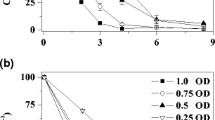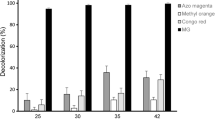Abstract
Dye wastewater normally is discharged at high temperature, but thermophilic bacteria capable of decolorizing azo dyes have rarely been isolated. Here we report a newly isolated moderately thermophilic bacterium, Novibacillus thermophilus SG-1, which had a remarkable ability to decolorize the azo dye Orange I by utilizing a large variety of organic substrates as electron donors. When Orange I served as the sole electron acceptor, almost complete decolorization occurred at 50ºC and pH 8.0 with acetate as the electron donor after anaerobic incubation of strain SG-1 for 24 h. The decolorization process followed the pseudofirst- order kinetics. The complete reduction of 0.3 mM Orange I was accompanied by a stoichiometric consumption of 0.17 mM acetate over time. The measured molar ratio (1.76) of Orange I reduced to acetate oxidized was close to the theory value of 2.0, suggesting that most of the electrons released by acetate had been transported to Orange I. Simultaneously energy generated from the electron transfer process was used to support cell anaerobic growth, which meant that azoreduction by strain SG-1 is an azorespiration process. To our knowledge, this is the first report of a thermophilic bacterium capable of azorespiration, which increases the limited number of bacteria for treating hightemperature azo dye wastewater.
Similar content being viewed by others
References
Pearcea, C. I., J. R. Lloydb, and J. T. Guthrie (2003) The removal of colour from textile wastewater using whole bacterial cells: A review. Dyes Pigm. 58: 179–196.
Xu, M., J. Guo, X. Kong, X. Chen, and G. Sun (2007) Fe(III)-enhanced azo reduction by Shewanella decolorationis S12. Appl. Microbiol. Biotechnol. 74: 1342–1349.
Fernando, E., T. Keshavarz, and G. Kyazze (2014) Complete degradation of the azo dye Acid Orange-7 and bioelectricity generation in an integrated microbial fuel cell, aerobic two-stage bioreactor system in continuous flow mode at ambient temperature. Bioresour. Technol. 156: 155–162.
Liao, C. S., C. H. Hung, and S. L. Chao (2013) Decolorization of azo dye reactive black B by Bacillus cereus strain HJ-1. Chemospher. 90: 2109–2114.
Robinson, T., G. McMullan, R. Marchant, and P. Nigam (2001) Remediation of dyes in textile effluent: A critical review on current treatment technologies with a proposed alternative. Bioresour. Technol. 77: 247–255.
Taha, M., E. M. Adetutu, E. Shahsavari, A. T. Smith, and A. S. Ball (2014) Azo and anthraquinone dye mixture decolourization at elevated temperature and concentration by a newly isolated thermophilic fungus, Thermomucor indicae-seudaticae. J. Environ. Chem. Eng. 2: 415–423.
Zhang, Y. B., Y. W. Jing, J. X. Zhang, L. F. Sun, and X. Quan (2010) Performance of a ZVI-UASB reactor for azo dye wastewater treatment. J. Chem. Technol. Biotechnol. 86: 199–204.
Blumel, S., H. J. Knackmuss, and A. Stolz (2002) Molecular cloning and characterization of the gene coding for the aerobic azoreductase from Xenophilus azovorans KF46F. Appl. Environ. Microbiol. 68: 3948–3955.
Yan, B., J. Zhou, J. Wang, C. Du, H. Hou, Z. Song, and Y. Bao (2004) Expression and characteristics of the gene encoding azoreductase from Rhodobacter sphaeroides AS1.1737. FEMS Microbiol. Lett. 236: 129–136.
Misal, S. A., D. P. Lingojwar, R. M. Shinde, and K. R. Gawai (2011) Purification and characterization of azoreductase from alkaliphilic strain Bacillus badius. Proc. Biochem. 46: 1264–1269.
Hong, Y., J. Guo, Z. Xu, M. Xu, and G. Sun (2007) Humic substances act as electron acceptor and redox mediators for microbial dissimilatory azoreduction by Shewanella decolorationis S12. J. Microbiol. Biotechnol. 17: 428–437.
Liu, G., J. Zhou, J. Wang, X. Wang, R. Jin, and H. Lv (2011) Decolorization of azo dyes by Shewanella oneidensis MR-1 in the presence of humic acids. Appl. Microbiol. Biotechnol. 91: 417–424.
Almeida, E. J. R. and C. R. Corso (2014) Comparative study of toxicity of azo dye Procion Red MX-5B following biosorption and biodegradation treatments with the fungi Aspergillus niger and Aspergillus terreus. Chemospher. 112: 317–322.
Shen, N., Y. C. Huo, J. J. Chen, F. Zhang, H. Zheng, and R. J. Zeng (2015) Decolorization by Caldicellulosiruptor saccharolyticus with dissolved hydrogen under extreme thermophilic conditions. Chem. Eng. J. 262: 847–853.
Solís, M., A. Solís, H. I. Pérez, N. Manjarrez, and M. Flores (2012) Microbial decolouration of azo dyes: A review. Proc. Biochem. 47: 1723–1748.
Kaushik, P. and A. Malik (2009) Fungal dye decolourization: Recent advances and future potential. Environ. Int. 35: 127–141.
Deivea, F. J., A. Domíngueza, T. Barrioa, F. Moscosoa, P. Moránb, M. A. Longoa, and M. A. Sanromán (2010) Decolorization of dye Reactive Black 5 by newly isolated thermophilic microorganisms from geothermal sites in Galicia (Spain). J. Hazard. Mater. 182: 735–742.
Chen, K. C., J. Y. Wu, D. J. Liou, and S. C. Hwang (2003) Decolorization of the textile dyes by newly isolated bacterial strains. J. Biotechnol. 101: 57–68.
Keck, A., J. Klein, M. Kudlich, A. Stolz, H. J. Knackmuss, and R. Mattes (1997) Reduction of azo dyes by redox mediators originating in the naphthalenesulfonic acid degradation pathway of Sphingomonas sp. strain BN6. Appl. Environ. Microbiol. 63: 3684–3690.
Ma, C., S. G. Zhou, Q. Lu, G. Q. Yang, D. M. Wang, L. Zhuang, F. B. Li, and F. M. Lei (2013) Decolorization of Orange I under alkaline and anaerobic conditions by a newly isolated humusreducing bacterium, Planococcus sp. MC01. Int. Biodeter. Biodegr. 83: 17–24.
Wang, H., J. Q. Su, X. W. Zheng, Y. Tian, X. J. Xiong, and T. L. Zheng (2009) Bacterial decolorization and degradation of the reactive dye Reactive Red 180 by Citrobacter sp. CK3. Int. Biodeter. Biodegr. 63: 395–399.
Yang, G. Q., J. H. Chen, and S. G. Zhou (2015) Novibacillus thermophilus gen. nov., sp. nov., a Gram-staining-negative and moderately thermophilic species within the family Thermoactinomycetaceae. Int. J. Syst. Evol. Microbiol. 65: 2591–2597.
Lovley, D. R. and E. J. P. Phillips (1988) Novel mode of microbial energy metabolism: Organic carbon oxidation coupled to dissimilatory reduction of iron or manganese. Appl. Environ. Microbiol. 54: 1472–1480.
Wu, C. Y., L. Zhuang, S. G. Zhou, F. B. Li, and X. M. Li (2010) Fe(III)-enhanced anaerobic transformation of 2,4-dichlorophenoxyacetic acid by an iron-reducing bacterium Comamonas koreensis CY01. FEMS Microbiol. Ecol. 71: 106–113.
Yu, Z., J. L. Wen, G. Q. Yang, J. Liu, and S. G. Zhou (2015) Compostibacillus humi gen. nov., sp. nov., a member of the family Bacillaceae, isolated from sludge compost. Int. J. Syst. Evol. Microbiol. 65: 346–352.
Aksu, Z. (2003) Reactive dye bioaccumulation by Saccharomyces cerevisiae. Proc. Biochem. 38: 1437–1444.
Saratale, R.G., G. D. Saratale, J. S. Chang, and S. P. Govindwar (2011) Bacterial decolorization and degradation of azo dyes: A review. J. Taiwan Inst. Chem. E. 42: 138–157.
Chen, G., M. Huang, L. Chen, and D. Chen (2011) A batch decolorization and kinetic study of Reactive Black 5 by a bacterial strain Enterobacter sp. GY-1. Int. Biodeter. Biodegr. 65: 790–796.
Hong, Y., M. Xu, J. Guo, Z. Xu, X. Chen, and G. Sun (2007) Respiration and growth of Shewanella decolorationis S12 with an azo compound as the sole electron acceptor. Appl. Environ. Microbiol. 73: 64–72.
Hong, Y. and J. Gu (2009) Bacterial anaerobic respiration and electron transfer relevant to the biotransformation of pollutants. Int. Biodeter. Biodegr. 63: 973–980.
Hong, Y., J. Guo, and G. Sun (2009) Energy generation coupled to the azoreduction by the membranous vesicles from Shewanella decolorationis S12. J. Microbiol. Biotechnol. 19: 37–41.
Hong, Y. and J. Gu (2010) Physiology and biochemistry of reduction of azo compounds by Shewanella strains relevant to electron transport chain. Appl. Microbiol. Biotechnol. 88: 637–643.
Author information
Authors and Affiliations
Corresponding author
Rights and permissions
About this article
Cite this article
Yu, Z., Zhou, X., Wang, Y. et al. Dissimilatory azoreduction of Orange I by a newly isolated moderately thermophilic bacterium, Novibacillus thermophilus SG-1. Biotechnol Bioproc E 20, 1064–1070 (2015). https://doi.org/10.1007/s12257-015-0365-9
Received:
Revised:
Accepted:
Published:
Issue Date:
DOI: https://doi.org/10.1007/s12257-015-0365-9




